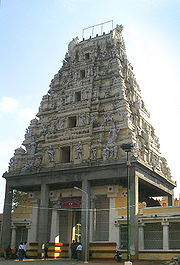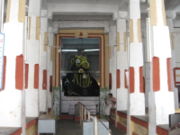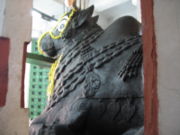
Nandi Temple
Encyclopedia



Bangalore
Bengaluru , formerly called Bengaluru is the capital of the Indian state of Karnataka. Bangalore is nicknamed the Garden City and was once called a pensioner's paradise. Located on the Deccan Plateau in the south-eastern part of Karnataka, Bangalore is India's third most populous city and...
, the capital of the state of Karnataka
Karnataka
Karnataka , the land of the Kannadigas, is a state in South West India. It was created on 1 November 1956, with the passing of the States Reorganisation Act and this day is annually celebrated as Karnataka Rajyotsava...
, India
India
India , officially the Republic of India , is a country in South Asia. It is the seventh-largest country by geographical area, the second-most populous country with over 1.2 billion people, and the most populous democracy in the world...
. The temple is exclusively for the worship of the sacred bull in Hinduism
Hinduism
Hinduism is the predominant and indigenous religious tradition of the Indian Subcontinent. Hinduism is known to its followers as , amongst many other expressions...
, known as Nandi
Nandi bull
Nandi or Nandin , is now universally supposed to be the name for the bull which serves as the mount of Shiva and as the gate keeper of Shiva and Parvati in Hindu mythology. Temples venerating Shiva and Parvati display stone images of a seated Nandi, generally facing the main shrine...
, Lord Shiva's vahana
Vahana
Vāhana denotes the being, typically an animal or mythical entity, a particular deva is said to use as a vehicle. In this capacity, the vāhana is often called the deity's mount. Upon the partnership between the deva and his vāhana is woven much iconography and mythology...
, or animal mount. The word "Nandi" means "joyful" in the Sanskrit
Sanskrit
Sanskrit , is a historical Indo-Aryan language and the primary liturgical language of Hinduism, Jainism and Buddhism.Buddhism: besides Pali, see Buddhist Hybrid Sanskrit Today, it is listed as one of the 22 scheduled languages of India and is an official language of the state of Uttarakhand...
language.
The temple was built in 1537 by a local ruler under the Vijayanagara empire
Vijayanagara Empire
The Vijayanagara Empire , referred as the Kingdom of Bisnaga by the Portuguese, was an empire based in South Indian in the Deccan Plateau region. It was established in 1336 by Harihara I and his brother Bukka Raya I of the Yadava lineage. The empire rose to prominence as a culmination of attempts...
in the Vijayanagara architectural style. The ruler, a feudatory chief named Kempe Gowda, also founded the city of Bangalore. The temple is named after the large granite Nandi monolith
Monolith
A monolith is a geological feature such as a mountain, consisting of a single massive stone or rock, or a single piece of rock placed as, or within, a monument...
placed on a plinth
Plinth
In architecture, a plinth is the base or platform upon which a column, pedestal, statue, monument or structure rests. Gottfried Semper's The Four Elements of Architecture posited that the plinth, the hearth, the roof, and the wall make up all of architectural theory. The plinth usually rests...
in the temple shrine (garbhagriha
Garbhagriha
Garbhagriha or Garbha griha is the small unlit shrine of a Hindu temple.Garbhagriha or ' is a Sanskrit word meaning the interior of the sanctum sanctorum, the innermost sanctum of a Hindu temple where resides the murti of the primary deity of the temple...
) which has become blackened from years of being rubbed with charcoal and oil. The temple is a small one, consisting only of the shrine fronted by a porch
Porch
A porch is external to the walls of the main building proper, but may be enclosed by screen, latticework, broad windows, or other light frame walls extending from the main structure.There are various styles of porches, all of which depend on the architectural tradition of its location...
in the Vijayanagara style. The current tower (vimana) over the shrine was constructed in the early 20th century and is adorned with Saivite figures and motifs.
It is said to house one of the largest Nandi murthis in the world. The height of the murthi is approximately 15 ft (4.6 m) and it is approximately 20 feet (6.1 m) long.

